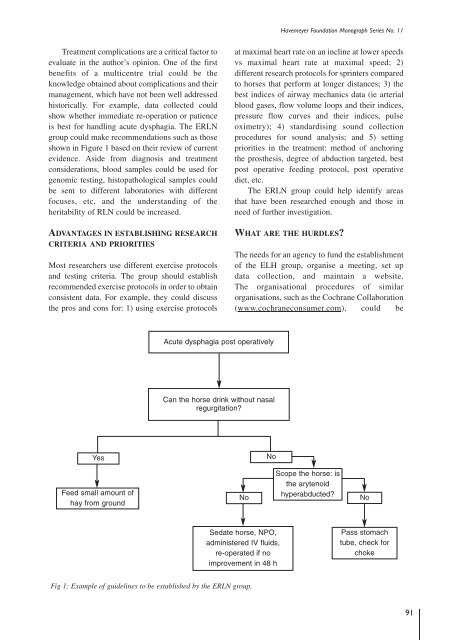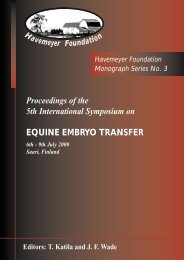Proceedings of a Workshop on - The Havemeyer Foundation
Proceedings of a Workshop on - The Havemeyer Foundation
Proceedings of a Workshop on - The Havemeyer Foundation
You also want an ePaper? Increase the reach of your titles
YUMPU automatically turns print PDFs into web optimized ePapers that Google loves.
<strong>Havemeyer</strong> Foundati<strong>on</strong> M<strong>on</strong>ograph Series No. 11<br />
Treatment complicati<strong>on</strong>s are a critical factor to<br />
evaluate in the author’s opini<strong>on</strong>. One <str<strong>on</strong>g>of</str<strong>on</strong>g> the first<br />
benefits <str<strong>on</strong>g>of</str<strong>on</strong>g> a multicentre trial could be the<br />
knowledge obtained about complicati<strong>on</strong>s and their<br />
management, which have not been well addressed<br />
historically. For example, data collected could<br />
show whether immediate re-operati<strong>on</strong> or patience<br />
is best for handling acute dysphagia. <strong>The</strong> ERLN<br />
group could make recommendati<strong>on</strong>s such as those<br />
shown in Figure 1 based <strong>on</strong> their review <str<strong>on</strong>g>of</str<strong>on</strong>g> current<br />
evidence. Aside from diagnosis and treatment<br />
c<strong>on</strong>siderati<strong>on</strong>s, blood samples could be used for<br />
genomic testing, histopathological samples could<br />
be sent to different laboratories with different<br />
focuses, etc, and the understanding <str<strong>on</strong>g>of</str<strong>on</strong>g> the<br />
heritability <str<strong>on</strong>g>of</str<strong>on</strong>g> RLN could be increased.<br />
ADVANTAGES IN ESTABLISHING RESEARCH<br />
CRITERIA AND PRIORITIES<br />
Most researchers use different exercise protocols<br />
and testing criteria. <strong>The</strong> group should establish<br />
recommended exercise protocols in order to obtain<br />
c<strong>on</strong>sistent data. For example, they could discuss<br />
the pros and c<strong>on</strong>s for: 1) using exercise protocols<br />
at maximal heart rate <strong>on</strong> an incline at lower speeds<br />
vs maximal heart rate at maximal speed; 2)<br />
different research protocols for sprinters compared<br />
to horses that perform at l<strong>on</strong>ger distances; 3) the<br />
best indices <str<strong>on</strong>g>of</str<strong>on</strong>g> airway mechanics data (ie arterial<br />
blood gases, flow volume loops and their indices,<br />
pressure flow curves and their indices, pulse<br />
oximetry); 4) standardising sound collecti<strong>on</strong><br />
procedures for sound analysis; and 5) setting<br />
priorities in the treatment: method <str<strong>on</strong>g>of</str<strong>on</strong>g> anchoring<br />
the prosthesis, degree <str<strong>on</strong>g>of</str<strong>on</strong>g> abducti<strong>on</strong> targeted, best<br />
post operative feeding protocol, post operative<br />
diet, etc.<br />
<strong>The</strong> ERLN group could help identify areas<br />
that have been researched enough and those in<br />
need <str<strong>on</strong>g>of</str<strong>on</strong>g> further investigati<strong>on</strong>.<br />
WHAT ARE THE HURDLES?<br />
<strong>The</strong> needs for an agency to fund the establishment<br />
<str<strong>on</strong>g>of</str<strong>on</strong>g> the ELH group, organise a meeting, set up<br />
data collecti<strong>on</strong>, and maintain a website.<br />
<strong>The</strong> organisati<strong>on</strong>al procedures <str<strong>on</strong>g>of</str<strong>on</strong>g> similar<br />
organisati<strong>on</strong>s, such as the Cochrane Collaborati<strong>on</strong><br />
(www.cochranec<strong>on</strong>sumer.com), could be<br />
Acute dysphagia post operatively<br />
Can the horse drink without nasal<br />
regurgitati<strong>on</strong>?<br />
Yes<br />
No<br />
Feed small amount <str<strong>on</strong>g>of</str<strong>on</strong>g><br />
hay from ground<br />
No<br />
Scope the horse: is<br />
the arytenoid<br />
hyperabducted?<br />
No<br />
Sedate horse, NPO,<br />
administered IV fluids,<br />
re-operated if no<br />
improvement in 48 h<br />
Pass stomach<br />
tube, check for<br />
choke<br />
Fig 1: Example <str<strong>on</strong>g>of</str<strong>on</strong>g> guidelines to be established by the ERLN group.<br />
91








